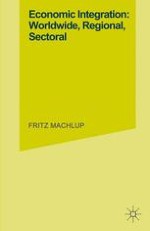1976 | Buch
Economic Integration: Worldwide, Regional, Sectoral
Proceedings of the Fourth Congress of the International Economic Association held in Budapest, Hungary
herausgegeben von: Professor Fritz Machlup
Verlag: Palgrave Macmillan UK
Buchreihe : International Economic Association Series
Enthalten in: Professional Book Archive
